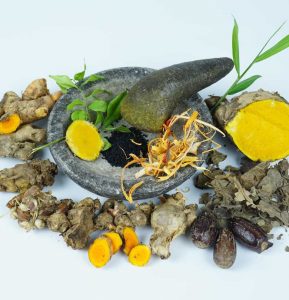Tracing Back the History of Jamu
"Lately, jamu has become a hot topic of discussion. Certain jamu are said to be able to protect the body from the Corona virus. People then buy and consume jamu in droves. In fact, if we look at our history, the efficacy of jamu has been felt since before 1600 years ago."Published by : administrator - 10/05/2020 17:02 WIB
2 Minutes read.
The origin and development of jamu is not fully known with certainty. This is because there is no documentation about the early development of the knowledge and traditional medicines or jamu. The origin or all stories related to the use of jamu by previous generations are passed down orally (by word of mouth) by parents to their children, from the previous generation to the next generation. However, in general, the historic development of jamu can be divided into five periods.

- Prehistoric Period
Diseases suffered by early humans varied, although the evidence obtained only from bones and teeth. The number of Pithecanthropus at this time is too small to draw conclusions about the use of biomedicine as a healing therapy. The study on the use of biomedicine is more on the study of fossil feces and kitchen waste.
- Pre-Colonial Period (Before 1600)
The earliest evidence of the internal (oral) and external (topical) use of plants is found in the 8th century. On the walls of Borobudur Temple there is a relief of the Kalpataru tree, which is a mythological tree that symbolizes ‘eternal life’. Under the tree there is a relief of people crushing materials for making jamu. Also found reliefs of women mixing plants for healing and body care. Another document was found in Bali, written on lontar (dry palm leaves). In general, the language used is Sanskrit or Old Javanese. For example, the term usada or usadi is found in the Kakawin Ramayana (898-910 AD).
- Colonial Period
The use of jamu is documented in serat (manuscript) and primbon (almanac) which are the ‘big book’ of Javanese medicine. One of the famous ones is Serat Centhini or Suluk Tembangraras which was documented by Kanjeng Gusti Pangeran Adipati Anom Amangkunegara III, Prince Sunan Pakubuwana IV (1788-1820 AD). In addition, there are also ancient manuscripts that tell about Javanese medicinal plants, such as in Serat Kawruh Chapter Jampi-Jampi (1831), Serat Wulang Wanita (Pakubuwana IX), and others.
- Japanese Colonial Period
The first jamu seminar was held in Solo in 1940, followed by the formation of a jamu committee. The committee is tasked with urging jamu entrepreneurs to voluntarily register personal prescriptions for inspection and evaluation by the Jawatan Kesehatan Rakyat (People’s Health Service). At the end of 1944, several selected medicinal plants were announced in the Asia Raya daily. Some of the selected plants include coffee beans, papaya leaves, betel leaves, starfruit flowers, etc.
- Independence Period
President Soekarno paid considerable attention to the development of jamu. Many researches on medicinal plants have begun. The government established a pharmacotherapy institute whose task was to investigate efficacious plants, build Hortus Medicus in Tawangmangu, and conduct research on herbal medicine. Documentation and research on various types of medicinal plants are increasingly being encouraged by various parties.
Reference
The Power of Jamu yang ditulis oleh Dr. Martha Tilaar dan Prof. Dr. Ir. Bernard T. Wijaya, MM.
Artikel Terkait:
Awal Mula Jamu Gendong
Tak Banyak Diketahui Orang, Berikut Fakta Menarik dari Jamu Gendong
Begini Idealnya Minum Jamu Gendong








